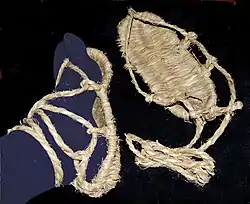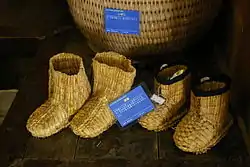草鞋
Chinese
grass; straw; draft (of a document) grass; straw; draft (of a document); careless; rough; manuscript; hasty | shoe | ||
|---|---|---|---|
| trad. (草鞋) | 草 | 鞋 | |
| simp. #(草鞋) | 草 | 鞋 | |
Pronunciation
Noun
草鞋
- straw sandal
Synonyms
- 千里馬/千里马 (qiānlǐmǎ)
| Variety | Location | Words edit |
|---|---|---|
| Formal (Written Standard Chinese) | 草鞋 | |
| Mandarin | Taiwan | 草鞋 |
| Xi'an | 草鞋 | |
| Guiyang | 草鞋 | |
| Xuzhou | 草呱子 | |
| Yangzhou | 蒲鞋, 草窩子, 毛窩子 | |
| Nanjing | 草鞋, 蒲鞋 | |
| Cantonese | Guangzhou | 草鞋 |
| Dongguan | 草鞋 | |
| Gan | Nanchang | 草鞋 |
| Lichuan | 草鞋 | |
| Hakka | Meixian | 草鞋 |
| Miaoli (N. Sixian) | 草鞋 | |
| Pingtung (Neipu; S. Sixian) | 草鞋 | |
| Hsinchu County (Zhudong; Hailu) | 草鞋 | |
| Taichung (Dongshi; Dabu) | 草鞋 | |
| Hsinchu County (Qionglin; Raoping) | 草鞋 | |
| Yunlin (Lunbei; Zhao'an) | 草鞋 | |
| Huizhou | Jixi | 草鞋 |
| Jin | Taiyuan | 草鞋 |
| Min Bei | Jian'ou | 草屩 |
| Min Dong | Fuzhou | 草鞋 |
| Min Nan | Shantou | 草鞋 |
| Southern Pinghua | Nanning (Tingzi) | 草鞋 |
| Wu | Shanghai (Chongming) | 草鞋, 蒲鞋 |
| Danyang | 草鞋 | |
| Hangzhou | 蒲鞋 | |
| Ningbo | 蒲鞋 | |
| Wenzhou | 蒲鞋 | |
| Jinhua | 草鞋 | |
| Xiang | Loudi | 草鞋 |
Derived terms
|
|
Related terms
- 涼鞋/凉鞋 (liángxié)
Japanese


Etymology 1
| Kanji in this term | |
|---|---|
| 草 | 鞋 |
| わら Grade: 1 | くつ > じ Hyōgaiji |
| irregular | |
/waraɡut͡su/ → /warand͡zu/ → /warand͡ʑi/ → /warad͡ʑi/
Originally a compound of 藁 (wara, “straw”) + 靴 (kutsu, “shoes, boots, footwear”).[1][2][3][4]
Appears with this reading during the Edo period (1603–1868).[5] Now the most common reading for the straw sandals sense.
The sense appears to have developed from straw footwear in general, to more specifically straw sandals. The oldest reading waragutsu is still current in modern Japanese with the 藁沓 spelling, now often referring more specifically to straw shoes or boots that enclose the feet.[1][2][3]
The kanji spelling is an example of jukujikun (熟字訓).
Alternative forms
- 藁沓, 鞋 (rare)
Pronunciation
- (Irregular reading)
- (Tokyo) わらじ [wàrájí] (Heiban – [0])[2][6][7]
- IPA(key): [ɰᵝa̠ɾa̠ʑi]
Noun
草鞋 • (waraji) ←わらぢ (waradi)?
- traditional Japanese straw sandals
Derived terms
- 草鞋虫 (waraji mushi), 鼠姑 (waraji mushi, “a woodlouse that cannot curl up into a ball”)
Etymology 2
| Kanji in this term | |
|---|---|
| 草 | 鞋 |
| わら Grade: 1 | くつ > んじ Hyōgaiji |
| irregular | |
/waraɡut͡su/ → /warand͡zu/ → /warand͡ʑi/
Originally a compound of 藁 (wara, “straw”) + 靴 (kutsu, “shoes, boots, footwear”).[1][2][3]
Appears with this reading in the late 1400s, during the Muromachi period (1336–1573). Superseded in modern usage by waraji above.
The kanji spelling is an example of jukujikun (熟字訓).
Pronunciation
- (Irregular reading)
- IPA(key): [ɰᵝa̠ɾã̠n(d͡)ʑi]
Noun
草鞋 • (waranji) ←わらんぢ (warandi)?
- (archaic) traditional Japanese straw sandals
Etymology 3
| Kanji in this term | |
|---|---|
| 草 | 鞋 |
| わら Grade: 1 | くつ > んず Hyōgaiji |
| irregular | |
/waraɡut͡su/ → /warand͡zu/ → /waranzu/
Originally a compound of 藁 (wara, “straw”) + 靴 (kutsu, “shoes, boots, footwear”).[1][2][3]
Appears with this reading in the The Tale of the Heike, compiled some time between 1185 and 1330. Superseded in modern usage by waraji above.
The kanji spelling is an example of jukujikun (熟字訓).
Pronunciation
- (Irregular reading)
- IPA(key): [ɰᵝa̠ɾã̠n(d͡)zɨᵝ]
Noun
草鞋 • (waranzu) ←わらんづ (warandu)?
- (archaic) traditional Japanese straw sandals
Etymology 4
| Kanji in this term | |
|---|---|
| 草 | 鞋 |
| わら Grade: 1 | くつ > ず Hyōgaiji |
| irregular | |
/waraɡut͡su/ → /waraud͡zu/ → /warad͡zu/ → /warazu/
Originally a compound of 藁 (wara, “straw”) + 靴 (kutsu, “shoes, boots, footwear”).[1]
Appears with this reading in the Kanchi-in edition of the Ruiju Myōgishō, compiled during the Kamakura period (1185–1333). Superseded in modern usage by waraji above.
The kanji spelling is an example of jukujikun (熟字訓).
Pronunciation
- (Irregular reading)
- IPA(key): [ɰᵝa̠ɾa̠zɨᵝ]
Noun
草鞋 • (warazu) ←わらづ (waradu)?
- (archaic, possibly obsolete) traditional Japanese straw sandals
Etymology 5
| Kanji in this term | |
|---|---|
| 草 | 鞋 |
| わら > わろ Grade: 1 | くつ > うず Hyōgaiji |
| irregular | |
/waraɡut͡su/ → /waraud͡zu/ → /warɔːd͡zu/ → /waroːd͡zu/ → /waroːzu/
Originally a compound of 藁 (wara, “straw”) + 靴 (kutsu, “shoes, boots, footwear”).[1][2][3]
Appears with this reading in the Utsubo Monogatari of the late 900s. Superseded in modern usage by waraji above for the straw sandal sense, and by 藁沓 (waragutsu) for the straw shoe or boot sense.
The kanji spelling is an example of jukujikun (熟字訓).
Alternative forms
- 藁沓
Pronunciation
- (Irregular reading)
- IPA(key): [ɰᵝa̠ɾo̞ːzɨᵝ]
Noun
草鞋 • (warōzu) ←わろうづ (waroudu)?
- (archaic) traditional Japanese straw sandals
- (archaic) traditional Japanese straw shoes or boots
Etymology 6
| Kanji in this term | |
|---|---|
| 草 | 鞋 |
| そう Grade: 1 | かい Hyōgaiji |
| on’yomi | |
From Middle Chinese 草鞋 (MC t͡sʰɑuX ɦˠɛ|ɦˠɛi, “straw shoe, straw sandal”).
Appears with this reading in the Konjaku Monogatarishū, compiled in the early 1100s.
Pronunciation
- Kan’yōyomi
- (Tokyo) そーかい [sòókáí] (Heiban – [0])[2]
- IPA(key): [so̞ːka̠i]
Noun
草鞋 • (sōkai) ←さうかい (saukai)?
- (rare) traditional Japanese straw sandals
- (rare) traditional Japanese straw shoes or boots
- Alternative spelling of 挿鞋: formal footwear made of wood and embroidery, worn by the emperor at court
Usage notes
The waraji reading above is more common for the straw sandals sense, and the term 藁沓 (waragutsu) is more common for the straw shoes or boots sense.
Etymology 7
| Kanji in this term | |
|---|---|
| 草 | 鞋 |
| そう Grade: 1 | かい > あい Hyōgaiji |
| kan’yōon | |
Shift from earlier sōkai reading (see above), adopting the kan'yōyomi of ai for the 鞋 character, rather than its regular kan'on reading of kai.[1][2]
Appears with this reading in the Taiheiki, compiled in the late 1300s. Superseded in modern usage by sōkai above.
Pronunciation
- Kan’yōyomi
- (Tokyo) そーあい [sòóáí] (Heiban – [0])
- IPA(key): [so̞ːa̠i]
Noun
草鞋 • (sōai) ←さうあい (sauai)?
- (archaic, possibly obsolete) traditional Japanese straw sandals
- (archaic, possibly obsolete) traditional Japanese straw shoes or boots
References
- 1988, 国語大辞典(新装版) (Kokugo Dai Jiten, Revised Edition) (in Japanese), Tōkyō: Shogakukan
- 2006, 大辞林 (Daijirin), Third Edition (in Japanese), Tōkyō: Sanseidō, →ISBN
- 1995, 大辞泉 (Daijisen) (in Japanese), Tōkyō: Shogakukan, →ISBN
- 1998, 広辞苑 (Kōjien), Fifth Edition (in Japanese), Tōkyō: Iwanami Shoten, →ISBN
- “わらうず”, in 世界大百科事典 第2版 (Sekai Dai-hyakka Jiten Dainihan, “Heibonsha World Encyclopedia Second Edition”) (in Japanese), Tōkyō: Heibonsha, 1998
- 1998, NHK日本語発音アクセント辞典 (NHK Japanese Pronunciation Accent Dictionary) (in Japanese), Tōkyō: NHK, →ISBN
- 1997, 新明解国語辞典 (Shin Meikai Kokugo Jiten), Fifth Edition (in Japanese), Tōkyō: Sanseidō, →ISBN